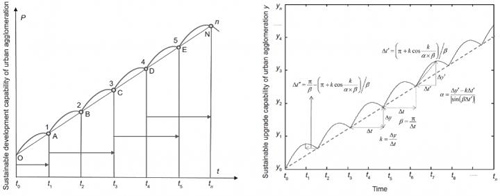The Joint Climbing Movement and Threshold of the Sustainable Development in the Urban Agglomeration
The Beijing-Tianjin-Hebei urban agglomeration is a world-class super-large urban agglomeration, which is the key construction in China, to alleviate Beijing's non-capital functions and promote the coordinated development of Beijing, Tianjin and Hebei.The Beijing-Tianjin-Hebei urban agglomeration is also the core area, which implements the Outline of the Beijing-Tianjin-Hebei Coordinated Development Plan proposed by the Central Committee of the Communist Party of China and promotes the coordinated development of Beijing, Tianjin and Hebei. A recent study quantitatively revealed the joint climbing law, climbing threshold and their verification process of the sustainable development in the Beijing-Tianjin-Hebei urban agglomeration.
The paper title of the related research is Quantitative simulation and verification of upgrade law of sustainable development in Beijing-Tianjin-Hebei urban agglomeration, which was published in the Sci China Earth Sci (SCIENTIA SINICA Terrae), 2019, and written by Prof. FANG Chuanglin and Master Liang Longwu, the Institute of Geographical Sciences and Natural Resources Research, Chinese Academy of Sciences.
The researchers discovered that there was a law of joint climb in the sustainable development of urban agglomerations for the first time. When city A can not enhance its sustainable development capability by relying on its own ability, it will naturally unite to a second city, B, for cooperation to create this enhancement; when the enhancement can not be maintained through the union with city B, it will naturally unite with a third city, C, and so on, the sustainable urban agglomeration is formed through city A continuing to unite the city B, C, ..., N. In theory, the number of cities with which a city needs to unite to maintain its sustainable development is limited, which is objectively constrained by the unite threshold and limited by the unite strength Figure 1. The authors solved out the sustainable upgrade function curve, upgrade rate, upgrade speed, joint climb threshold and joint climb strength of the urban agglomerations by geometrical derivation. Taking the Beijing-Tianjin-Hebei urban agglomeration as an example, the 2000-2015 data was used to verify the change trend of the comprehensive sustainable climbing capacity of urban agglomerations, which basically conformed to the law of sustainable climbing curve. The research showed that from 2000 to 2015, as the core city of the Beijing-Tianjin-Hebei urban agglomeration, Beijing, to enhance its sustainable upgrade capability, jointly developed with Tianjin, Langfang, and Baoding before 2000, Tangshan in 2002, Cangzhou in 2009, Zhangjiakou and Shijiazhuang in 2012, and Chengde in 2014. By 2015, the comprehensive unite strength between Beijing and four cities (Handan, Qinhuangdao, Hengshui, and Xingtai) was still lower than the unite threshold of 6.14. These four cities are relatively far from Beijing, and offer no substantial contribution to the sustainable upgrade capability of Beijing.
QUANTITATIVE ANALYSIS OF THE SUSTAINABLE UPGRADE CAPABILITY CURVE OF URBAN AGGLOMERATION (Image by FANG Chuanglin's team)

The results of this study provided a quantitative decision-making support basis for the coordinated development of the Beijing-Tianjin-Hebei urban agglomeration, and provided theoretical guidance and algorithms for calculating the number of cities in the sustainable development of other urban agglomerations across the country.(SCIENCE CHINA PRESS)
This research was funded by the Major Program of National Natural Science Foundation of China: "Coupled mechanism and interactive coercing effects between urbanization and eco-environment in mega-urban agglomerations".
See the article: Chuanglin FANG, Longwu LIANG & Zhenbo WANG.2019.Quantitative simulation and verification of upgrade law of sustainable development in Beijing-Tianjin-Hebei urban agglomeration. SCIENCE CHINA Earth Sciences ,62, https://doi.org/10.1007/s11430-019-9430-7.
Download attachments: